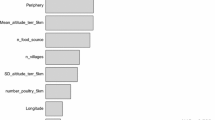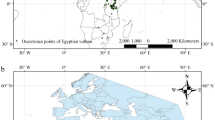Abstract
The Egyptian Vulture (Neophron percnopterus) is an endangered species with a globally declining population. Information on the current habitat distribution and potential suitable habitat for this ecologically important species will provide invaluable insight into conservation planning and the species’ future status as climate changes. This is specifically important for areas where there are little or no reported data on the status of the Egyptian Vulture. We used 13 years nest-site records (n = 69) together with relevant environmental variables to understand the known distribution and predict potential habitat distribution of the Egyptian Vulture in the Kurdistan Region of Iraq. A machine learning model, maximum entropy, was used to generate various model options, from which the best model was selected based on the Akaike information criterion (AICc) statistical indicators. The model showed reasonably good discriminative ability using both True Skill Statistics TSS = 0.722 and Area under the Curve (AUC) = 0.825 metrics. The Egyptian Vultures in Iraq mainly breed in territories at elevations between 1000 and 3300 m above sea level. This suggests that the species shows preference to areas distant from human settlements likely due to decreased disturbance and that the species may rely on alternative/complementary food sources (e.g. wild goat and boar). The total area of the study site is approximately 51,069 km2, out of which around 25% (12,767 km2) is predicted as suitable breeding habitat for the Egyptian Vulture. The output of this study provides useful baseline information for conservation actions and plans.



Similar content being viewed by others
References
Abdulhasan N et al. (2016) Key biodiversity areas of Iraq. Tablet House Publishing, Iraq
Allouche O, Tsoar A, Kadmon R (2006) Assessing the accuracy of species distribution models: prevalence, kappa and the true skill statistic (TSS). J Appl Ecol 43:1223–1232
Al-Quraishi AMF, Qader SH, Wu W (2020) Drought monitoring using spectral and meteorological based indices combination: a case study in Sulaimaniyah, Kurdistan region of Iraq. In: Environmental Remote Sensing and GIS in Iraq. Springer, pp 377–393
Angelov I, Hashim I, Oppel S (2013) Persistent electrocution mortality of Egyptian Vultures Neophron percnopterus over 28 years C Africa. Bird Conserv Int 23:1–6
Angelov I, Bougain C, Schulze M, Al Sariri T, McGrady M, Meyburg B-U (2020) A globally-important stronghold in Oman for a resident population of the endangered Egyptian Vulture Neophron Percnopterus. Ardea 108:1–10
Arkumarev V, Dobrev V, Abebe YD, Popgeorgiev G, Nikolov SC (2014) Congregations of wintering Egyptian Vultures Neophron percnopterus in Afar, Ethiopia: present status and implications for conservation. Ostrich 85:139–145
Awchi TA, Kalyana MM (2017) Meteorological drought analysis in northern Iraq using SPI and GIS Sustainable. Water Resour Manage 3:451–463
Bibby C, Jones M, Marsden S (1998) Expedition field techniques bird survey royal geographical society 1 Kensington Gore London SW72AR
Boyce MS, Vernier PR, Nielsen SE, Schmiegelow FK (2002) Evaluating resource selection functions. Ecol Modell 157:281–300
Burnham KP, Anderson DR (2002) A practical information-theoretic approach Model selection and multimodel inference, 2nd edn. Springer, New York
Carrete M, Grande JM, Tella JL, Sánchez-Zapata JA, Donázar JA, Díaz-Delgado R, Romo A (2007) Habitat, human pressure, and social behavior: partialling out factors affecting large-scale territory extinction in an endangered vulture. Biol Conserv 136:143–154
Dobrev V et al (2016) Diet is not related to productivity but to territory occupancy in a declining population of Egyptian Vultures Neophron percnopterus. Bird Conserv Int 26:273–285
Dormann CF et al (2013) Collinearity: a review of methods to deal with it and a simulation study evaluating their performance. Ecography 36:27–46
Elith J, Leathwick JR (2009) Species distribution models: ecological explanation and prediction across space and time. Ann Rev Ecol Evol Syst 40:677–697
Elith J et al (2006) Novel methods improve prediction of species’ distributions from occurrence data. Ecography 29:129–151
Elith J, Phillips SJ, Hastie T, Dudík M, Chee YE, Yates CJ (2011) A statistical explanation of MaxEnt for ecologists. Divers Distrib 17:43–57
Farashi A, Alizadeh-Noughani M (2019) Niche modelling of the potential distribution of the Egyptian Vulture Neophron percnopterus during summer and winter in Iran, to identify gaps in protected area coverage. Bird Conserv Int 29:423–436
Ferguson-Lees J, Christie DA, Franklin K (2001) Raptors of the world. Christopher Helm
Fourcade Y, Engler JO, Rödder D, Secondi J (2014) Mapping species distributions with MAXENT using a geographically biased sample of presence data: a performance assessment of methods for correcting sampling bias. PLoS ONE 9:e97122
García-Ripollés C, López-López P, Urios V (2010) First description of migration and wintering of adult Egyptian vultures Neophron percnopterus tracked by GPS satellite telemetry. Bird Study 57:261–265
Gaznayee HA, Al-Quraishi AMF (2019) Analysis of agricultural drought’s severity and impacts in Erbil Province, the Iraqi Kurdistan Region based on time series NDVI and TCI indices for 1998 through 2017. J Adv Res Dyn Control Syst 11:287–297
Green RE, Newton I, Shultz S, Cunningham AA, Gilbert M, Pain DJ, Prakash V (2004) Diclofenac poisoning as a cause of vulture population declines across the Indian subcontinent. J Appl Ecol 41:793–800
Hanley JA, McNeil BJ (1982) The meaning and use of the area under a receiver operating characteristic (ROC) curve. Radiology 143:29–36
Hidalgo S, Zabala J, Zuberogoitia I, Azkona A, Castillo I (2005) Food of the Egyptian vulture (Neophron percnopterus) in Biscay. Buteo 14:23–29
Hoel PG (1943) The accuracy of sampling methods in ecology. Ann Math Stat 14:289–300
Jiménez-Valverde A (2014) Threshold-dependence as a desirable attribute for discrimination assessment: implications for the evaluation of species distribution models. Biodivers Conserv 23:369–385
Jiménez-Valverde A, Lobo JM (2007) Threshold criteria for conversion of probability of species presence to either–or presence–absence. Acta Oecol 31:361–369
Katzenberger J, Tabur E, Şen B, Isfendİyaroğlu S, Erkol IL, Oppel S (2019) No short-term effect of closing a rubbish dump on reproductive parameters of an Egyptian Vulture population in Turkey. Bird Conserv Int 29:71–82
KC KB, Koju NP, Bhusal KP, Low M, Ghimire SK, Ranabhat R, Panthi S (2019) Factors influencing the presence of the endangered Egyptian vulture Neophron percnopterus in Rukum Nepal. Glob Ecol Conserv 20:e00727
Khwarahm NR (2020) Mapping current and potential future distributions of the oak tree (Quercus aegilops) in the Kurdistan Region, Iraq. Ecol Process 9:1–16
Khwarahm NR (2021) Spatial modeling of land use and land cover change in Sulaimani, Iraq, using multitemporal satellite data. Environ Monit Assess 193:1–18
Khwarahm NR, Qader S, Ararat K, Al-Quraishi AMF (2021a) Predicting and mapping land cover/land use changes in Erbil/Iraq using CA-Markov synergy model. Earth Sci Inf 14:393–406
Khwarahm NR, Ararat K, Qader S, Sabir DK (2021b) Modeling the distribution of the Near Eastern fire salamander (Salamandra infraimmaculata) and Kurdistan newt (Neurergus derjugini) under current and future climate conditions in Iraq. Ecol Inf 63:101309
Kramer-Schadt S et al (2013) The importance of correcting for sampling bias in MaxEnt species distribution models. Divers Distrib 19:1366–1379
Liu C, White M, Newell G (2013) Selecting thresholds for the prediction of species occurrence with presence-only data. J Biogeogr 40:778–789
López-López P, García-Ripollés C, Urios V (2014) Food predictability determines space use of endangered vultures: implications for management of supplementary feeding. Ecol Appl 24:938–949
Loveridge R et al (2019) Poisoning causing the decline in South-East Asia’s largest vulture population. Bird Conserv Int 29:41–54
Malinowski JC (2002) Iraq: a geography
Margalida A (2012) Baits, budget cuts: a deadly mix. Science 338:192–192
Margalida A, García D, Cortés-Avizanda A (2007) Factors influencing the breeding density of Bearded vultures, Egyptian vultures and Eurasian griffon vultures in Catalonia (NE Spain): management implications. Animal Biodivers Conserv 30:189–200
Mateo-Tomás P, Olea PP (2009) Combining scales in habitat models to improve conservation planning in an endangered vulture. Acta Oecologica 35:489–498
Mateo-Tomás P, Olea PP (2015) Livestock-driven land use change to model species distributions: Egyptian vulture as a case study. Ecol Ind 57:331–340
Mayaux P et al (2006) Validation of the global land cover 2000 map. IEEE Trans Geosci Remote Sens 44:1728–1739
Merow C, Smith MJ, Silander JA Jr (2013) A practical guide to MaxEnt for modeling species’ distributions: what it does, and why inputs and settings matter. Ecography 36:1058–1069
Oaks JL et al (2004) Diclofenac residues as the cause of vulture population decline in Pakistan. Nature 427:630–633
Ogada DL, Keesing F, Virani MZ (2012) Dropping dead: causes and consequences of vulture population declines worldwide. Ann N Y Acad Sci 1249:57–71
Ogada D et al (2016) Another continental vulture crisis: Africa’s vultures collapsing toward extinction. Conserv Lett 9:89–97
Oppel S et al (2015) High juvenile mortality during migration in a declining population of a long-distance migratory raptor. Ibis 157:545–557
Oppel S et al (2017) Landscape factors affecting territory occupancy and breeding success of Egyptian Vultures on the Balkan Peninsula. J Ornithol 158:443–457
Pantović U, Andevski J (2018) Review of the problem of poison use and vulture poisoning in the Balkan Peninsula Vulture Conservation Foundation, Netherlands
Phillips SJ, Dudík M, Schapire RE A maximum entropy approach to species distribution modeling. In: Proceedings of the twenty-first international conference on Machine learning, 2004. p 83
Phillips SJ, Anderson RP, Schapire RE (2006) Maximum entropy modeling of species geographic distributions. Ecol Model 190:231–259
Radosavljevic A, Anderson RP (2014) making better Maxent models of species distributions: complexity, overfitting and evaluation. J Biogeogr 41:629–643
Safford R et al (2019) Vulture conservation: the case for urgent action. Bird Conserv Int 29:1–9
Salim MA, Al-Sheikhly OF, Majeed K, Porter R (2012) An annotated checklist of the birds of Iraq. Sandgrouse 34:3–44
Sarà M, Di Vittorio M (2003) Factors influencing the distribution, abundance and nest-site selection of an endangered Egyptian vulture (Neophron percnopterus) population in Sicily. In: Animal Conservation Forum, 2003. vol 4. Cambridge University Press, pp 317–328
Şen B, Tavares JP, Bilgin CC (2017) Nest site selection patterns of a local Egyptian Vulture Neophron percnopterus population in Turkey. Bird Conserv Int 27:568–581
Sharrock JTR (2010) The atlas of breeding birds in Britain and Ireland. A&C Black
Sissakian V, Jabbar MA, Al-Ansari N, Knutsson S (2015) Development of Gulley Ali Beg Gorge in Rawandooz Area Northern Iraq. Engineering 7:16–30
Sutherland WJ, Pullin AS, Dolman PM, Knight TM (2004) The need for evidence-based conservation. Trends Ecol Evol 19:305–308
Tauler H, Real J, Hernandez-Matias A, Aymerich P, Baucells J, Martorell C, Santandreu J (2015) Identifying key demographic parameters for the viability of a growing population of the endangered Egyptian Vulture Neophron percnopterus. Bird Conserv Int 25:426–439
Venette RC (2015) Pest risk modelling and mapping for invasive alien species, vol 7. CABI, Wallingford
Warren DL, Seifert SN (2011) Ecological Niche Modeling in maxent: the importance of model complexity and the performance of model selection criteria. Ecol Appl 21:335–342
Warren DL, Glor RE, Turelli M (2010) ENMTools: a toolbox for comparative studies of environmental niche models. Ecography 33:607–611
Zuberogoitia I, Zabala J, Martínez J, González-Oreja J, López-López P (2014) Effective conservation measures to mitigate the impact of human disturbances on the endangered Egyptian vulture. Anim Conserv 17:410–418
Acknowledgements
We would like to express our gratitude to Dr. Volen Arkumarev from the Bulgarian Society for the Protection of Birds/BirdsLife Bulgaria for reviewing and providing invaluable comments and feedback on the manuscript. Richard Porter’s advice and teachings on designing fieldwork and bird surveys have been invaluable. We also would like to thank NI and the KBF for supporting the survey efforts, without which this paper could not have been written. We also would like to thank the anonymous reviewers for their valuable comments and feedback.
Funding
No funding was received for this study.
Author information
Authors and Affiliations
Contributions
The author(s) read and approved the final manuscript.
Corresponding author
Ethics declarations
Conflict of interest
The authors declare that they have no conflict of interest.
Rights and permissions
About this article
Cite this article
Khwarahm, N.R., Ararat, K., Qader, S. et al. Modelling Habitat Suitability for the Breeding Egyptian Vulture (Neophron percnopterus) in the Kurdistan Region of Iraq. Iran J Sci Technol Trans Sci 45, 1519–1530 (2021). https://doi.org/10.1007/s40995-021-01150-z
Received:
Accepted:
Published:
Issue Date:
DOI: https://doi.org/10.1007/s40995-021-01150-z







